MBS 665: Article Critique on Business Valuation - Finance Report
VerifiedAdded on 2023/06/13
|6
|1635
|356
Report
AI Summary
This report presents a critique of an article on business valuation, focusing on its relevance to the topics covered in MBS 665 Business Valuation. The critique assesses the article's key issues, including the goal of valuation, basis of value, premise of value, and different valuation approaches such as income, market, and cost approaches. The report evaluates the article's strengths and weaknesses, noting areas where the author made assumptions or omitted information. It also points out the absence of references and suggests improvements. This assignment solution is available on Desklib, where students can find more resources like past papers and solved assignments.
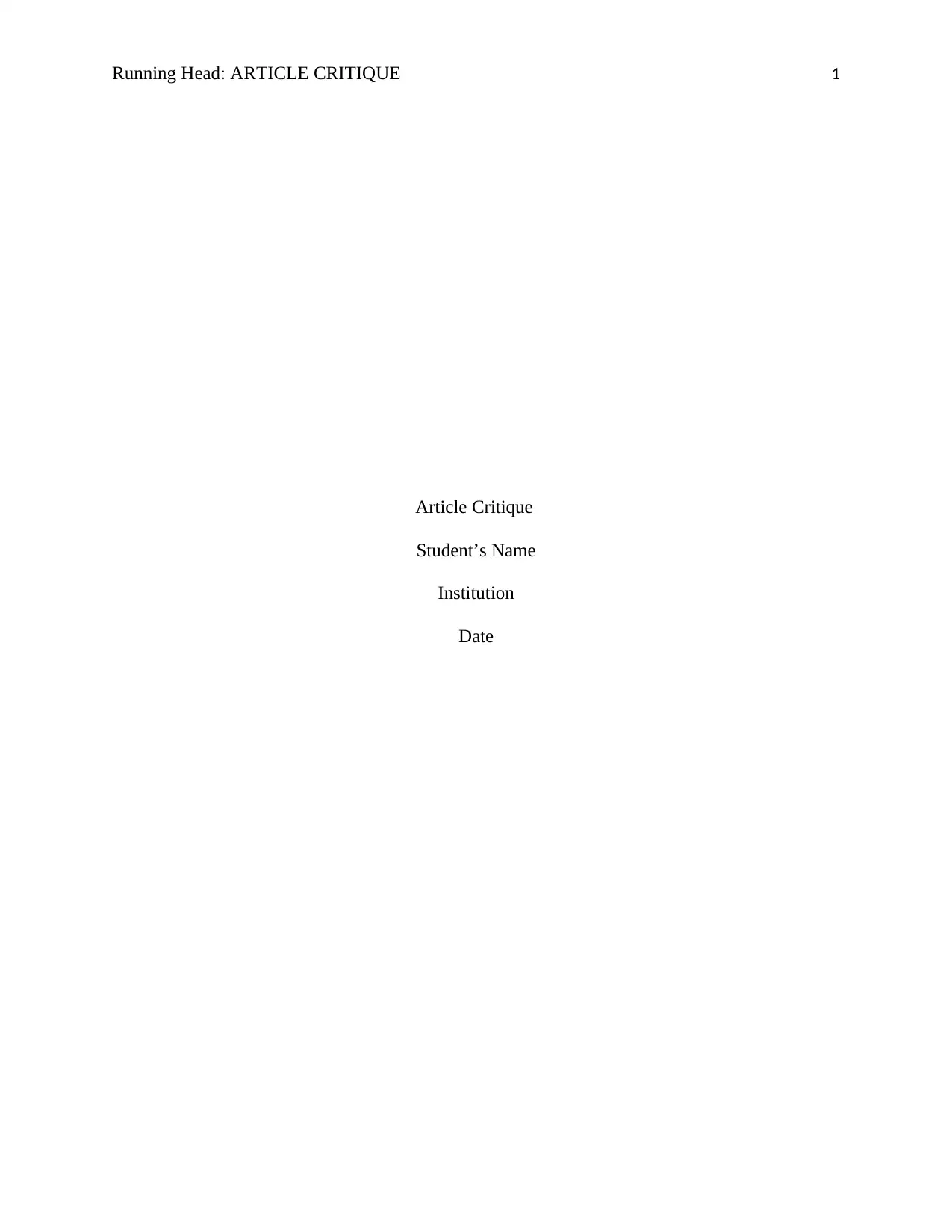
Running Head: ARTICLE CRITIQUE 1
Article Critique
Student’s Name
Institution
Date
Article Critique
Student’s Name
Institution
Date
Paraphrase This Document
Need a fresh take? Get an instant paraphrase of this document with our AI Paraphraser
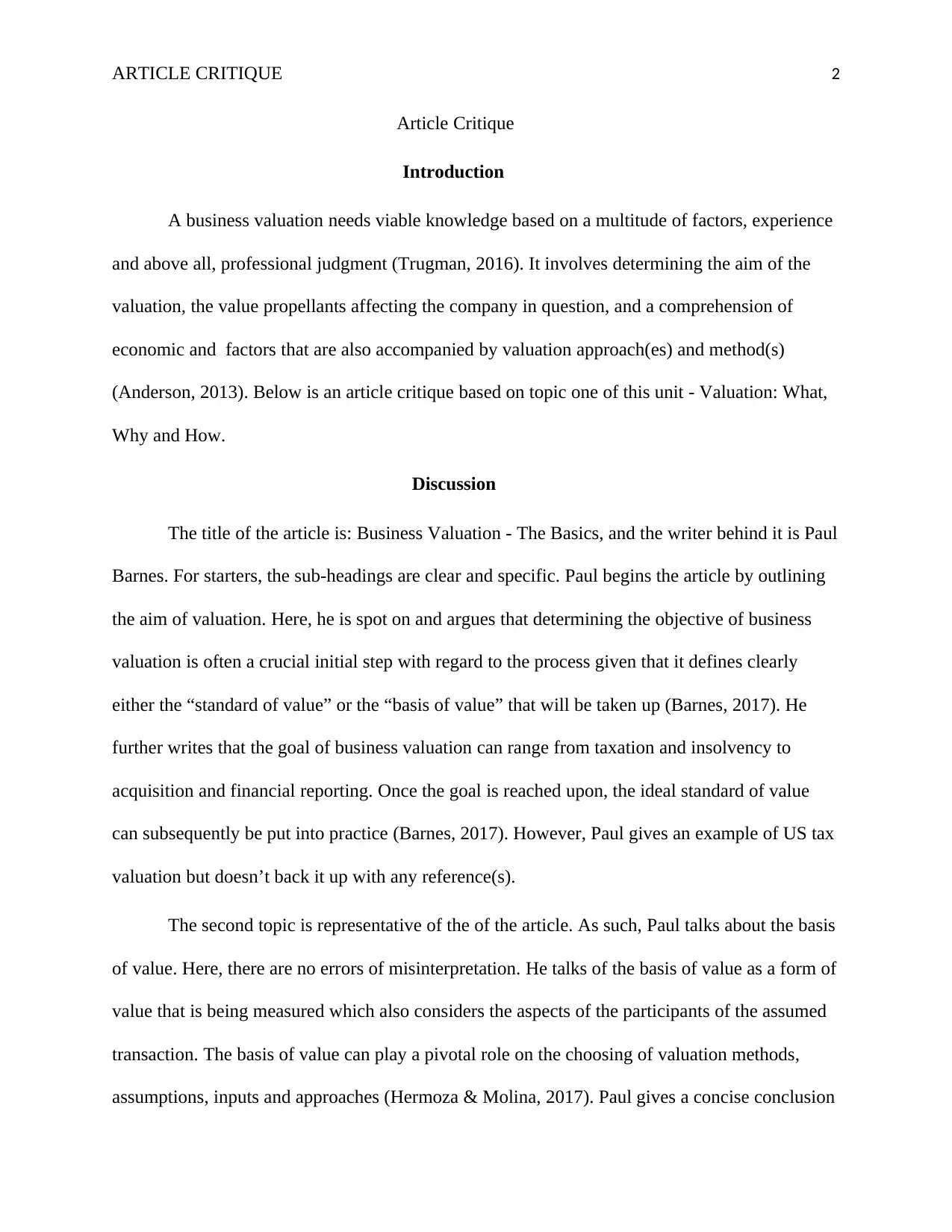
ARTICLE CRITIQUE 2
Article Critique
Introduction
A business valuation needs viable knowledge based on a multitude of factors, experience
and above all, professional judgment (Trugman, 2016). It involves determining the aim of the
valuation, the value propellants affecting the company in question, and a comprehension of
economic and factors that are also accompanied by valuation approach(es) and method(s)
(Anderson, 2013). Below is an article critique based on topic one of this unit - Valuation: What,
Why and How.
Discussion
The title of the article is: Business Valuation - The Basics, and the writer behind it is Paul
Barnes. For starters, the sub-headings are clear and specific. Paul begins the article by outlining
the aim of valuation. Here, he is spot on and argues that determining the objective of business
valuation is often a crucial initial step with regard to the process given that it defines clearly
either the “standard of value” or the “basis of value” that will be taken up (Barnes, 2017). He
further writes that the goal of business valuation can range from taxation and insolvency to
acquisition and financial reporting. Once the goal is reached upon, the ideal standard of value
can subsequently be put into practice (Barnes, 2017). However, Paul gives an example of US tax
valuation but doesn’t back it up with any reference(s).
The second topic is representative of the of the article. As such, Paul talks about the basis
of value. Here, there are no errors of misinterpretation. He talks of the basis of value as a form of
value that is being measured which also considers the aspects of the participants of the assumed
transaction. The basis of value can play a pivotal role on the choosing of valuation methods,
assumptions, inputs and approaches (Hermoza & Molina, 2017). Paul gives a concise conclusion
Article Critique
Introduction
A business valuation needs viable knowledge based on a multitude of factors, experience
and above all, professional judgment (Trugman, 2016). It involves determining the aim of the
valuation, the value propellants affecting the company in question, and a comprehension of
economic and factors that are also accompanied by valuation approach(es) and method(s)
(Anderson, 2013). Below is an article critique based on topic one of this unit - Valuation: What,
Why and How.
Discussion
The title of the article is: Business Valuation - The Basics, and the writer behind it is Paul
Barnes. For starters, the sub-headings are clear and specific. Paul begins the article by outlining
the aim of valuation. Here, he is spot on and argues that determining the objective of business
valuation is often a crucial initial step with regard to the process given that it defines clearly
either the “standard of value” or the “basis of value” that will be taken up (Barnes, 2017). He
further writes that the goal of business valuation can range from taxation and insolvency to
acquisition and financial reporting. Once the goal is reached upon, the ideal standard of value
can subsequently be put into practice (Barnes, 2017). However, Paul gives an example of US tax
valuation but doesn’t back it up with any reference(s).
The second topic is representative of the of the article. As such, Paul talks about the basis
of value. Here, there are no errors of misinterpretation. He talks of the basis of value as a form of
value that is being measured which also considers the aspects of the participants of the assumed
transaction. The basis of value can play a pivotal role on the choosing of valuation methods,
assumptions, inputs and approaches (Hermoza & Molina, 2017). Paul gives a concise conclusion
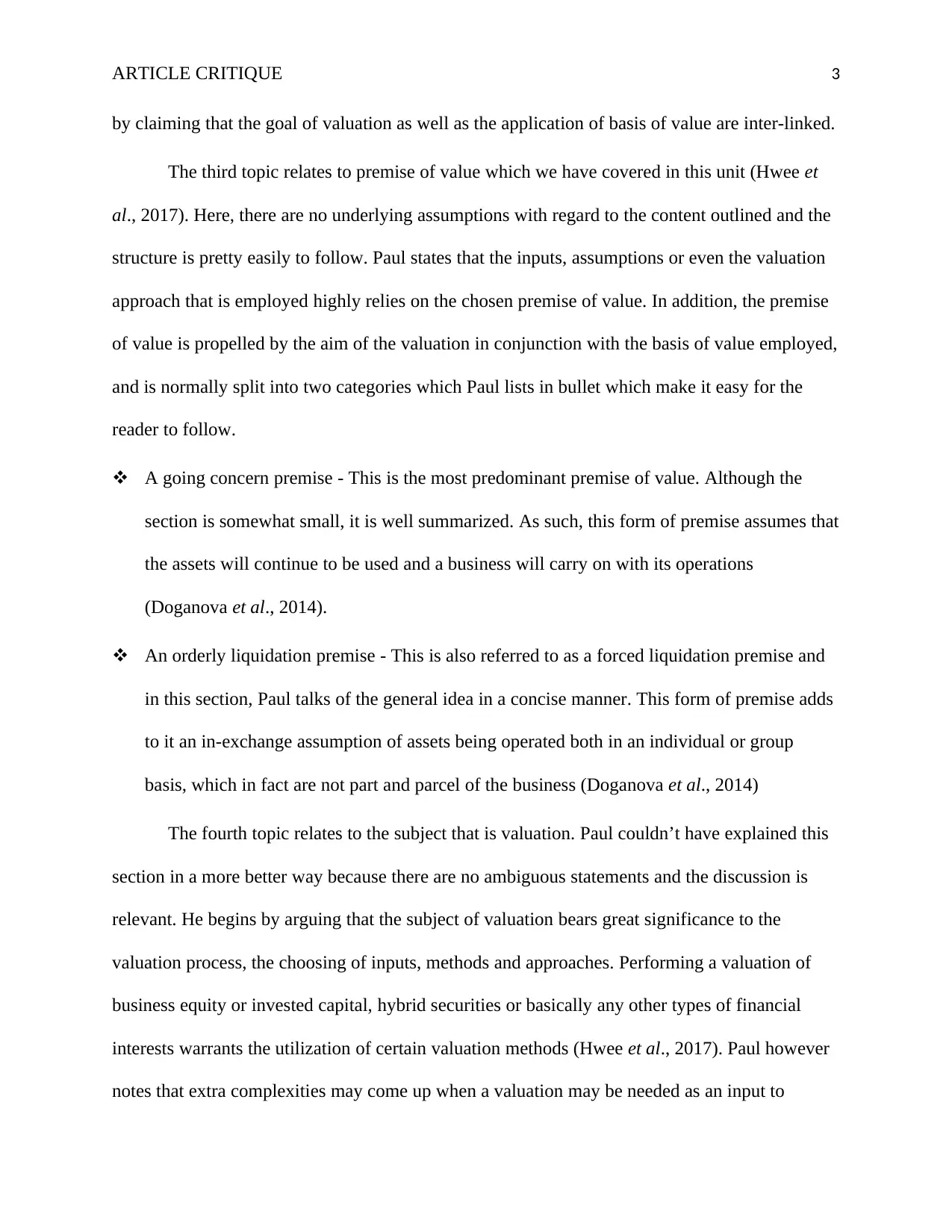
ARTICLE CRITIQUE 3
by claiming that the goal of valuation as well as the application of basis of value are inter-linked.
The third topic relates to premise of value which we have covered in this unit (Hwee et
al., 2017). Here, there are no underlying assumptions with regard to the content outlined and the
structure is pretty easily to follow. Paul states that the inputs, assumptions or even the valuation
approach that is employed highly relies on the chosen premise of value. In addition, the premise
of value is propelled by the aim of the valuation in conjunction with the basis of value employed,
and is normally split into two categories which Paul lists in bullet which make it easy for the
reader to follow.
A going concern premise - This is the most predominant premise of value. Although the
section is somewhat small, it is well summarized. As such, this form of premise assumes that
the assets will continue to be used and a business will carry on with its operations
(Doganova et al., 2014).
An orderly liquidation premise - This is also referred to as a forced liquidation premise and
in this section, Paul talks of the general idea in a concise manner. This form of premise adds
to it an in-exchange assumption of assets being operated both in an individual or group
basis, which in fact are not part and parcel of the business (Doganova et al., 2014)
The fourth topic relates to the subject that is valuation. Paul couldn’t have explained this
section in a more better way because there are no ambiguous statements and the discussion is
relevant. He begins by arguing that the subject of valuation bears great significance to the
valuation process, the choosing of inputs, methods and approaches. Performing a valuation of
business equity or invested capital, hybrid securities or basically any other types of financial
interests warrants the utilization of certain valuation methods (Hwee et al., 2017). Paul however
notes that extra complexities may come up when a valuation may be needed as an input to
by claiming that the goal of valuation as well as the application of basis of value are inter-linked.
The third topic relates to premise of value which we have covered in this unit (Hwee et
al., 2017). Here, there are no underlying assumptions with regard to the content outlined and the
structure is pretty easily to follow. Paul states that the inputs, assumptions or even the valuation
approach that is employed highly relies on the chosen premise of value. In addition, the premise
of value is propelled by the aim of the valuation in conjunction with the basis of value employed,
and is normally split into two categories which Paul lists in bullet which make it easy for the
reader to follow.
A going concern premise - This is the most predominant premise of value. Although the
section is somewhat small, it is well summarized. As such, this form of premise assumes that
the assets will continue to be used and a business will carry on with its operations
(Doganova et al., 2014).
An orderly liquidation premise - This is also referred to as a forced liquidation premise and
in this section, Paul talks of the general idea in a concise manner. This form of premise adds
to it an in-exchange assumption of assets being operated both in an individual or group
basis, which in fact are not part and parcel of the business (Doganova et al., 2014)
The fourth topic relates to the subject that is valuation. Paul couldn’t have explained this
section in a more better way because there are no ambiguous statements and the discussion is
relevant. He begins by arguing that the subject of valuation bears great significance to the
valuation process, the choosing of inputs, methods and approaches. Performing a valuation of
business equity or invested capital, hybrid securities or basically any other types of financial
interests warrants the utilization of certain valuation methods (Hwee et al., 2017). Paul however
notes that extra complexities may come up when a valuation may be needed as an input to
⊘ This is a preview!⊘
Do you want full access?
Subscribe today to unlock all pages.

Trusted by 1+ million students worldwide
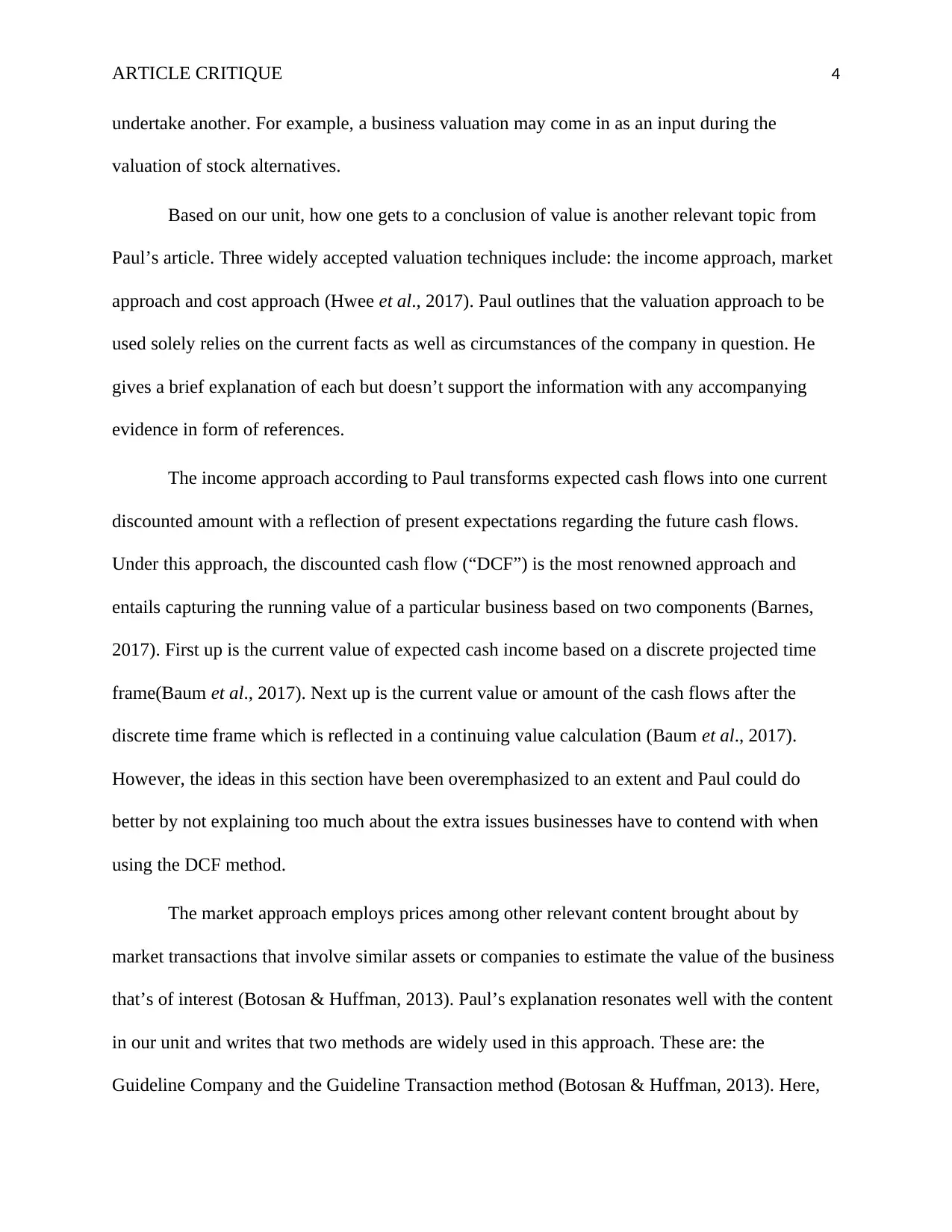
ARTICLE CRITIQUE 4
undertake another. For example, a business valuation may come in as an input during the
valuation of stock alternatives.
Based on our unit, how one gets to a conclusion of value is another relevant topic from
Paul’s article. Three widely accepted valuation techniques include: the income approach, market
approach and cost approach (Hwee et al., 2017). Paul outlines that the valuation approach to be
used solely relies on the current facts as well as circumstances of the company in question. He
gives a brief explanation of each but doesn’t support the information with any accompanying
evidence in form of references.
The income approach according to Paul transforms expected cash flows into one current
discounted amount with a reflection of present expectations regarding the future cash flows.
Under this approach, the discounted cash flow (“DCF”) is the most renowned approach and
entails capturing the running value of a particular business based on two components (Barnes,
2017). First up is the current value of expected cash income based on a discrete projected time
frame(Baum et al., 2017). Next up is the current value or amount of the cash flows after the
discrete time frame which is reflected in a continuing value calculation (Baum et al., 2017).
However, the ideas in this section have been overemphasized to an extent and Paul could do
better by not explaining too much about the extra issues businesses have to contend with when
using the DCF method.
The market approach employs prices among other relevant content brought about by
market transactions that involve similar assets or companies to estimate the value of the business
that’s of interest (Botosan & Huffman, 2013). Paul’s explanation resonates well with the content
in our unit and writes that two methods are widely used in this approach. These are: the
Guideline Company and the Guideline Transaction method (Botosan & Huffman, 2013). Here,
undertake another. For example, a business valuation may come in as an input during the
valuation of stock alternatives.
Based on our unit, how one gets to a conclusion of value is another relevant topic from
Paul’s article. Three widely accepted valuation techniques include: the income approach, market
approach and cost approach (Hwee et al., 2017). Paul outlines that the valuation approach to be
used solely relies on the current facts as well as circumstances of the company in question. He
gives a brief explanation of each but doesn’t support the information with any accompanying
evidence in form of references.
The income approach according to Paul transforms expected cash flows into one current
discounted amount with a reflection of present expectations regarding the future cash flows.
Under this approach, the discounted cash flow (“DCF”) is the most renowned approach and
entails capturing the running value of a particular business based on two components (Barnes,
2017). First up is the current value of expected cash income based on a discrete projected time
frame(Baum et al., 2017). Next up is the current value or amount of the cash flows after the
discrete time frame which is reflected in a continuing value calculation (Baum et al., 2017).
However, the ideas in this section have been overemphasized to an extent and Paul could do
better by not explaining too much about the extra issues businesses have to contend with when
using the DCF method.
The market approach employs prices among other relevant content brought about by
market transactions that involve similar assets or companies to estimate the value of the business
that’s of interest (Botosan & Huffman, 2013). Paul’s explanation resonates well with the content
in our unit and writes that two methods are widely used in this approach. These are: the
Guideline Company and the Guideline Transaction method (Botosan & Huffman, 2013). Here,
Paraphrase This Document
Need a fresh take? Get an instant paraphrase of this document with our AI Paraphraser
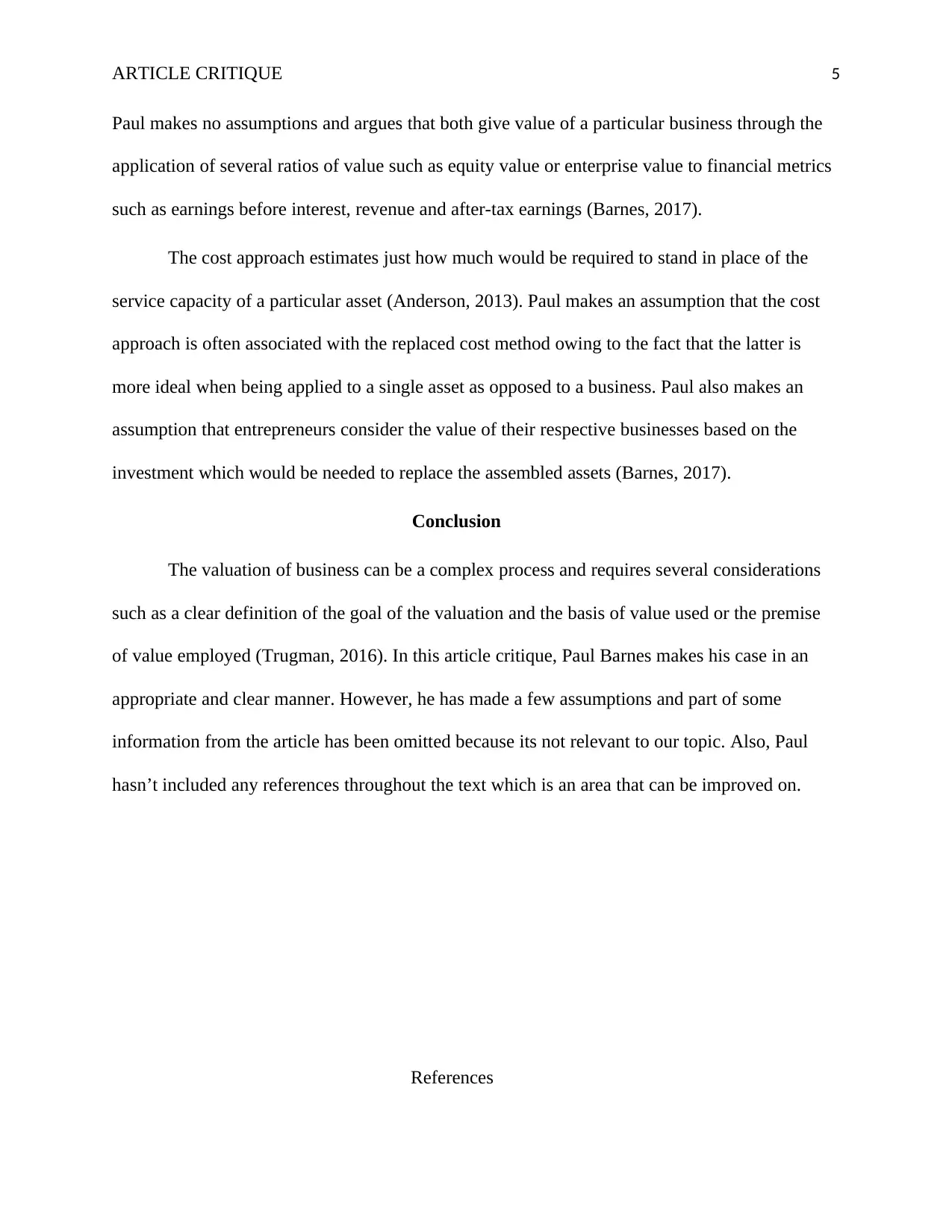
ARTICLE CRITIQUE 5
Paul makes no assumptions and argues that both give value of a particular business through the
application of several ratios of value such as equity value or enterprise value to financial metrics
such as earnings before interest, revenue and after-tax earnings (Barnes, 2017).
The cost approach estimates just how much would be required to stand in place of the
service capacity of a particular asset (Anderson, 2013). Paul makes an assumption that the cost
approach is often associated with the replaced cost method owing to the fact that the latter is
more ideal when being applied to a single asset as opposed to a business. Paul also makes an
assumption that entrepreneurs consider the value of their respective businesses based on the
investment which would be needed to replace the assembled assets (Barnes, 2017).
Conclusion
The valuation of business can be a complex process and requires several considerations
such as a clear definition of the goal of the valuation and the basis of value used or the premise
of value employed (Trugman, 2016). In this article critique, Paul Barnes makes his case in an
appropriate and clear manner. However, he has made a few assumptions and part of some
information from the article has been omitted because its not relevant to our topic. Also, Paul
hasn’t included any references throughout the text which is an area that can be improved on.
References
Paul makes no assumptions and argues that both give value of a particular business through the
application of several ratios of value such as equity value or enterprise value to financial metrics
such as earnings before interest, revenue and after-tax earnings (Barnes, 2017).
The cost approach estimates just how much would be required to stand in place of the
service capacity of a particular asset (Anderson, 2013). Paul makes an assumption that the cost
approach is often associated with the replaced cost method owing to the fact that the latter is
more ideal when being applied to a single asset as opposed to a business. Paul also makes an
assumption that entrepreneurs consider the value of their respective businesses based on the
investment which would be needed to replace the assembled assets (Barnes, 2017).
Conclusion
The valuation of business can be a complex process and requires several considerations
such as a clear definition of the goal of the valuation and the basis of value used or the premise
of value employed (Trugman, 2016). In this article critique, Paul Barnes makes his case in an
appropriate and clear manner. However, he has made a few assumptions and part of some
information from the article has been omitted because its not relevant to our topic. Also, Paul
hasn’t included any references throughout the text which is an area that can be improved on.
References
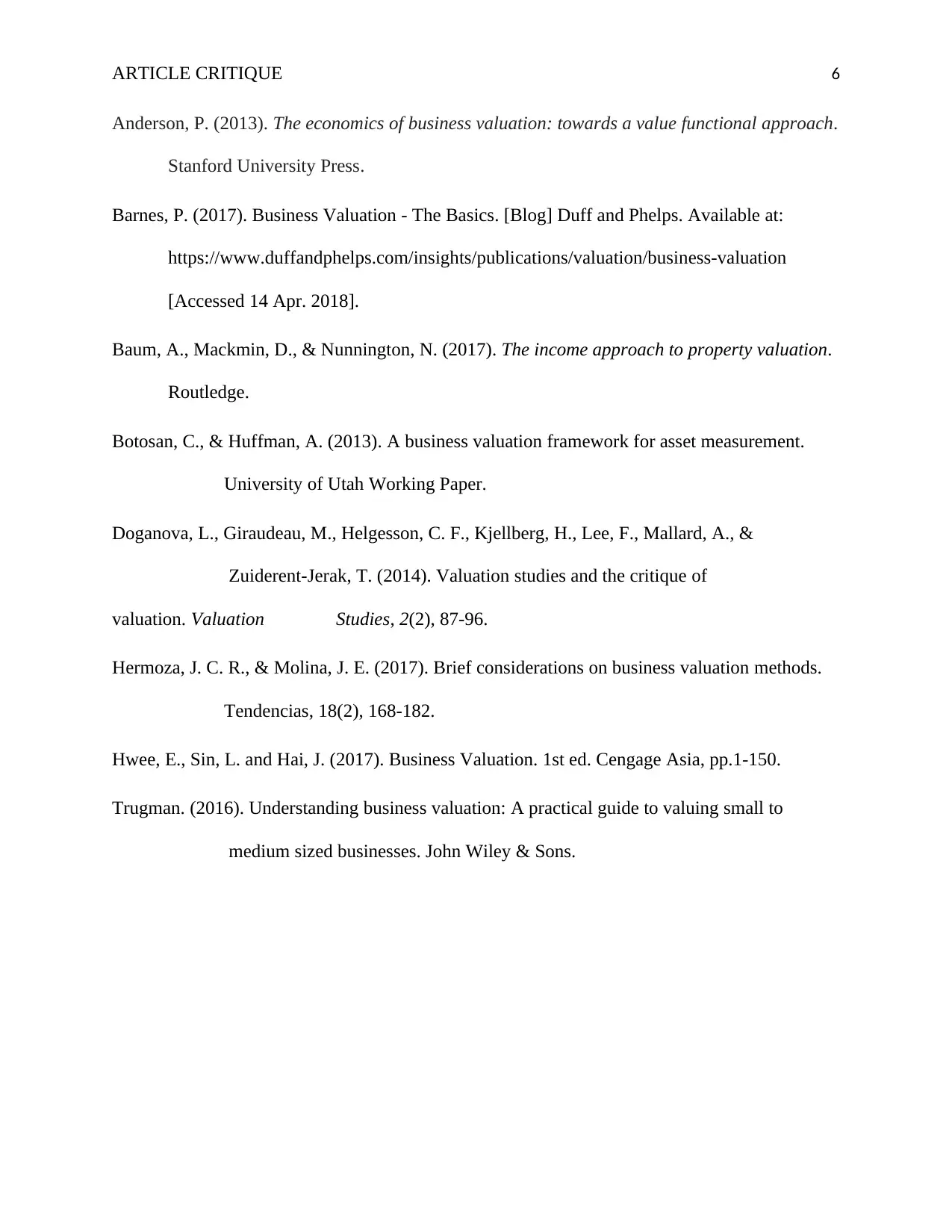
ARTICLE CRITIQUE 6
Anderson, P. (2013). The economics of business valuation: towards a value functional approach.
Stanford University Press.
Barnes, P. (2017). Business Valuation - The Basics. [Blog] Duff and Phelps. Available at:
https://www.duffandphelps.com/insights/publications/valuation/business-valuation
[Accessed 14 Apr. 2018].
Baum, A., Mackmin, D., & Nunnington, N. (2017). The income approach to property valuation.
Routledge.
Botosan, C., & Huffman, A. (2013). A business valuation framework for asset measurement.
University of Utah Working Paper.
Doganova, L., Giraudeau, M., Helgesson, C. F., Kjellberg, H., Lee, F., Mallard, A., &
Zuiderent-Jerak, T. (2014). Valuation studies and the critique of
valuation. Valuation Studies, 2(2), 87-96.
Hermoza, J. C. R., & Molina, J. E. (2017). Brief considerations on business valuation methods.
Tendencias, 18(2), 168-182.
Hwee, E., Sin, L. and Hai, J. (2017). Business Valuation. 1st ed. Cengage Asia, pp.1-150.
Trugman. (2016). Understanding business valuation: A practical guide to valuing small to
medium sized businesses. John Wiley & Sons.
Anderson, P. (2013). The economics of business valuation: towards a value functional approach.
Stanford University Press.
Barnes, P. (2017). Business Valuation - The Basics. [Blog] Duff and Phelps. Available at:
https://www.duffandphelps.com/insights/publications/valuation/business-valuation
[Accessed 14 Apr. 2018].
Baum, A., Mackmin, D., & Nunnington, N. (2017). The income approach to property valuation.
Routledge.
Botosan, C., & Huffman, A. (2013). A business valuation framework for asset measurement.
University of Utah Working Paper.
Doganova, L., Giraudeau, M., Helgesson, C. F., Kjellberg, H., Lee, F., Mallard, A., &
Zuiderent-Jerak, T. (2014). Valuation studies and the critique of
valuation. Valuation Studies, 2(2), 87-96.
Hermoza, J. C. R., & Molina, J. E. (2017). Brief considerations on business valuation methods.
Tendencias, 18(2), 168-182.
Hwee, E., Sin, L. and Hai, J. (2017). Business Valuation. 1st ed. Cengage Asia, pp.1-150.
Trugman. (2016). Understanding business valuation: A practical guide to valuing small to
medium sized businesses. John Wiley & Sons.
⊘ This is a preview!⊘
Do you want full access?
Subscribe today to unlock all pages.

Trusted by 1+ million students worldwide
1 out of 6
Your All-in-One AI-Powered Toolkit for Academic Success.
+13062052269
info@desklib.com
Available 24*7 on WhatsApp / Email
![[object Object]](/_next/static/media/star-bottom.7253800d.svg)
Unlock your academic potential
Copyright © 2020–2025 A2Z Services. All Rights Reserved. Developed and managed by ZUCOL.